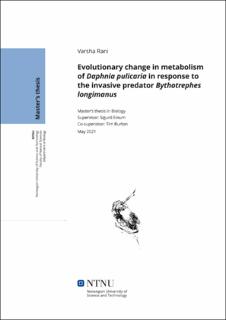| dc.description.abstract | Invasive predators have been identified as one of several threats to global biodiversity. This makes it necessary to understand their potential lethal and non-lethal impacts on native species, communities, and ecosystems. Interactions between invasive predators and native prey can lead prey to adapt as a part of an ‘evolutionary arms race’. Several studies suggest changes in behaviour, morphology, life history, and physiological characteristics of the prey as a result of direct selection imposed by the predator. However, much less emphasis has been directed towards indirect selective pressures induced by invasive predators, acting through a change in trophic control of the prey species (i.e., from bottom-up to top-down control). Metabolic rate is one of the candidate traits that can be hypothesised to evolve in response to such a change in trophic control, even in the absence of direct selection. This trait has been linked with essential physiological and life-history traits, such as growth, reproductive output, and survival, which makes it important to understand its evolutionary response to environmental change. In the current study I address this question by utilising an invasive event by the predatory zooplankton Bythotrephes longimanus in Lake Mendota, Wisconsin, US. This invasion dramatically impacted the prey species Daphnia pulicaria, causing a ~60% decline in their biomass. Resurrected clones from the pre-invasion period were obtained from resting eggs collected from sediment cores, and the metabolic rate of these was measured and compared with that of contemporary clones. Based on previous studies, I hypothesised the evolution of an increased metabolic rate in response to the predator invasion. However, the results showed a lower predicted metabolic rate for post-invasive clones than pre-invasive clones across the whole range of body lengths. One potential explanation for this observation is that the prey species remains bottom-up controlled due to a behavioural shift, whereby they increase their use of deeper, cooler, and less productive habitats. Thus, although this is one of the first studies to demonstrate evolutionary changes in metabolic rates in response to an invasive predator, further work is required to fully understand the evolution of this trait in response to ecological change.
Keywords- Invasive species, metabolic rate, evolutionary response, vertical migration, anti-predatory behaviour | |
